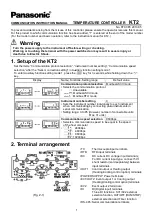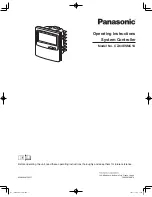
Step 7 of Ramp-Hold Programming in the red box at
right shows you how to zero out the segments you don’t
need. (Entering a rate of 0 for the first segment you
don’t need zeroes out the rest of the segments.)
When entering a Ramp-Hold program for the first
time, press
1
after
[USER]
appears. Your first firing
will be stored as Program 1. (See Step 2 at right.)
Each time you store another program, select the next
available number, such as 2, at the
[USER]
prompt. Se-
lecting a number for a new program over-writes
(erases) any program stored there. Write down your
user programs for quick reference. (Copy the blank
forms on page 37 and keep them in a 3-ring binder.)
Pointer:
For repeat firings that you don’t want to
inadvertently change, see Program Lock, page 25.
Firing a Stored User Program
After you enter a new program and the display shows
[IDLE]
, the new program is in memory and ready to fire.
Selecting a different stored program takes only sec-
onds:
1
From
[IDLE]
press
4
.
2
[USER]
will appear. Enter the program number (1
- 35).
3
If there are no changes to the program, press
STOP
.
[IDLE]
will appear. The controller is ready
to fire your selected program. To begin firing, press
ENTER
once.
Pointer:
Use Program Review to be sure you are
firing the correct program! From
[IDLE]
or even
after the firing has started, press
6
. The values for
the program will appear.
Rate as Degrees Per Hour
Each segment must include a rate, which is the firing
speed of that segment. We measure rate as degrees per
hour. This is similar to miles per hour; just replace miles
with degrees. During programming, enter the rate when
[RA]
appears. (
[RA]
will also include the segment num-
ber:
[RA 1] [RA 2]
etc.)
Keep the kiln lid or door closed when the kiln is not in use.
15
Ramp-Hold Programming
Use these instructions for your first firings. Later you
may prefer “Ramp-Hold Shorthand Instructions,” inside
back cover.
As you follow these steps, you will see values (tempera-
tures, rates, etc.) from the last firing. To use these again,
press
ENTER
. To program a controlled cooling, set the
segment to a lower target temperature than that of the pre-
vious segment.
To fire without Alarm or Delay: Follow steps 1
through 7. Then press
START
once.
1
Apply power to the kiln.
[8888]
then
[IDLE]
will
appear. (Press
ENTER
if
[IDLE]
does not appear.)
2
Press
4
.
[USER]
will appear. Enter a program num-
ber from 1 to 35.
3
Press
ENTER
.
[RA 1]
will appear. Enter firing rate
for segment 1 (temperature change per hour: from
1° to 9999°).
Note:
If you have selected Time in the Rate op-
tion, enter the time needed to reach the target
temperature for that segment. (See next page.)
4
Press
ENTER
.
[°F 1]
(or
[°C 1]
) will appear. Enter
the target temperature of segment 1.
5
Press
ENTER
.
[HD 1]
will appear. Enter segment 1
hold time in hours / minutes (e.g. 12 hours, 30 min-
utes = 12.30). No hold = 00.00.
6
Press
ENTER
. If
[FN 1]
appears, and you have an
AOP receptacle on your kiln, use the 1 or 2 key to
select ON or OFF. Press
ENTER
. (For more de-
tails on AOP, see next page.)
7
Continue entering values for the segments needed.
When
[RA _]
appears for the first segment you
don’t need, press
0
then
ENTER
.
[IDLE]
will ap-
pear. The kiln is ready to fire.
8
To set Alarm:
press
7
.
[ALAR]
will appear. Enter
alarm temperature. (Enter
0
to turn alarm off.)
Then press
ENTER
.
[IDLE]
will appear.
9
To set Delay:
press
3
.
[DELA]
will appear. Enter
delay time (i.e. 12 hours, 30 minutes = 12.30). Then
press
ENTER
.
[IDLE]
will appear. (Delay zeroes
out after each completed firing.)
10
To start program:
From
[IDLE]
press
ENTER
once.
[-ON-]
will appear, then kiln temperature. If
a delay was programmed,
[DELA]
will appear, then
time remaining until start. To stop the firing at any
time, press
STOP.
We recommend using Program Review (page 8) before
firing. When the program fires to completion,
[CPLT]
will
appear and the controller will beep. Press
ENTER
.
[IDLE]
will appear.
















































